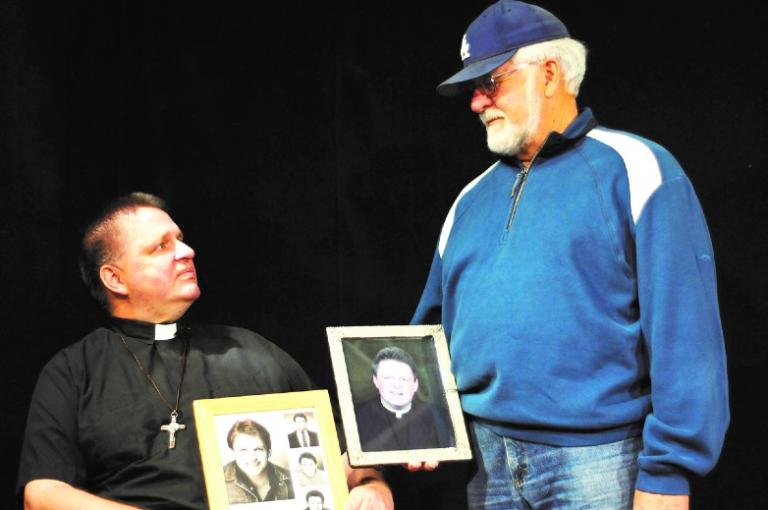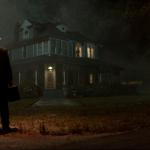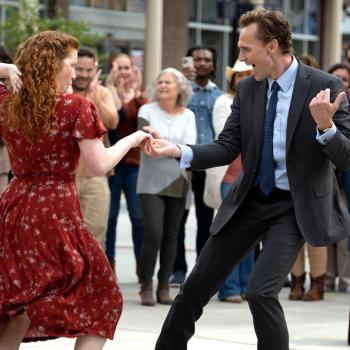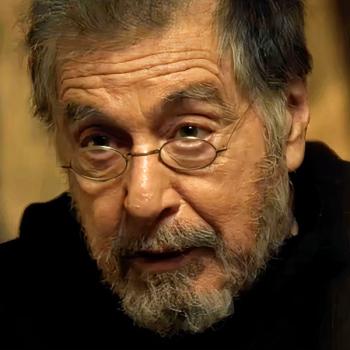
On June 9, 2014, Father Stuart Long, subject of Mark Wahlberg’s upcoming movie Father Stu, passed away at the age of 50 at the Big Sky Care Center in Helena, Montana. It was the end of a too-short life that saw him move from prizefighter to actor to museum manager to Catholic convert to Catholic priest.
What’s the Story Behind the Father Stu Movie?
For the last six years, actor Wahlberg — himself a Catholic revert — has been trying to launch a biopic of Father Stu, and the cameras are finally rolling. Mel Gibson plays the part of Bill Long, Stu’s father, and Gibson’s romantic and professional partner, writer-director Rosalind Ross, is also doing both those jobs for Father Stu.
Teresa Ruiz (Narcos: Mexico) co-stars, playing Stu’s girlfriend (pre-ordination, of course).
According to press reports, the normally buff 49-year-old Wahlberg, who’s a bit of a fitness fanatic, has buzzed his hair and gained 30 pounds for the role.
Before his own religious conversion, Wahlberg led a rough life, including serious tangles with the law. As anyone familiar with Gibson knows, he produced The Passion of the Christ (and is doing a sequel), but his personal faith life is far from exemplary.
So, maybe they’re the perfect guys to tackle the up-and-down story of Father Stu.
Who Was Father Stu?
Born in Seattle in 1963, Stuart Long moved as a toddler with his parents to their hometown of Helena. A high-school wrestler and football player, he went on to attend Carroll College, which is Catholic (but Stu was not). He also developed a passion for boxing and won Golden Gloves titles.
A smashed jaw ended his boxing career, so Long headed to Los Angeles to break into movies. After minor success, he became disenchanted with the film industry (and working as a bouncer), so he went to work for the Norton Simon Museum in Pasadena, eventually becoming the manager.
Long met a beautiful Catholic woman and was encouraged to convert to marry her, but fate — or God — intervened. The aftereffects of an earlier motorcycle accident had awakened his interest in religious faith, and then his baptism as a Catholic caused him to feel called to the priesthood.
After a stint with the Capuchin Franciscans in New York (where he met Father Benedict Groeschel), the friars sent Long to Franciscan University in Steubenville, Ohio, where he earned a master’s degree in philosophy.
Long decided to become a priest for the Diocese of Helena and did his formation at Mount Angel Seminary in Oregon. While there, he underwent surgery for a tumor on his hip. Subsequently, doctors discovered he had a rare autoimmune disease, inclusion body myositis, which mimics ALS, or Lou Gehrig’s disease.
There is no cure. By the time he was ordained, Father Stu was already on crutches.
“There’s a lot of power in redemptive suffering, and that’s exactly how he lived.” Bishop George Thomas
Bishop George Thomas, now at the Diocese of Las Vegas, was then the bishop of Helena, and he had a decision to make.
In a Skype chat, he recalls, “So, my struggle was whether or not I would call him to Holy Orders, for a couple of reasons. One is, obviously, he’d have a very short active priesthood; there are tremendous costs associated with this kind of care, a lot of question marks.
“But I kept being prompted by the Holy Spirit, moving forward the Holy Orders. And in my estimation, there’s a lot of power in redemptive suffering, and that’s exactly how he lived.
“His priesthood was about six years altogether, and he was stunningly effective in those years. And things like, I’d go to visit him at the rehab center, which was really a rehab nursing home. And it would not be unusual to have six or eight or 10 people lined up outside his room waiting to go to confession.”
“[Father Stu] Was Very Christlike.” Father Sean Raftis
One of those was Father Sean Raftis, who’s still serving the Diocese of Helena (and whose exploits with a group of friends loosely inspired the movie Tag — more on that here).
“He was my confessor for years,” says Father Raftis in a phone chat, “and my spiritual director. Stu was in this chair in a room at the Big Sky Care Center. I’d always go there for confessions, and I’d see lines of people waiting to talk to him, to get direction or just to visit.”
But, why?
“He was very Christlike,” says Father Raftis. “It was great, because he was a great priest, but he was like an old shoe, in a way. He could talk to anybody. He was just a very charismatic man. He just drew so many people to him. And it was very interesting, because the time he drew so many people to him is when he was suffering the most.”
Says Bishop Thomas, “His Masses were deeply moving. As his disease progressed, he became more and more debilitated. One of the most powerful images is, he had Mass at Carroll College for all the students. He was so weak at this stage that as he reads the Words of Institution [or Consecration] during the Mass, one of the students would take his hand and help lift up the Host.”
“By the time the last Easter Vigil of his life was to be celebrated, he had just so wanted his mom and dad to become Catholic.” Bishop Thomas
Father Stu not only brought friends and strangers to faith.
“Another image I have,” says Bishop Thomas, “that literally is embedded in my memory was by the time the last Easter Vigil of his life was to be celebrated, he had just so wanted his mom and dad to become Catholic. So, they decided to be baptized at the Easter Vigil before his death.
“He was so weak at that time that he was on a gurney. They wheeled him into the cathedral, and he’s just literally flat on his back. I had him brought back to the baptismal font, and I baptized his parents.
“But as I did that, there were tears coming down his face. And I thought it was like the prayer, the Nunc Dimittis, “Now you can dismiss your servant. Everything he wanted in life was his.” So that was just again, a powerful, touching and beautiful image.”
“[Wahlberg] said … ‘I would like to do something beautiful for the Church.” Bishop Thomas
According to Bishop Thomas, about six years ago, Wahlberg contacted him while he was still in Montana.
“He wanted to learn a little bit more about Father Stu’s life, but also he said, ‘I’d like your blessing to be able to move this forward.’ He described what he wanted to do, and he said something like, ‘The Church has been through so much; I would like to do something beautiful for the Church.
“And I said, ‘That’s certainly a great way to start. By all means, I would give my blessing and support.'”
Bishop Thomas’ Message for Mark Wahlberg
Asked what he’d like to say to Wahlberg now that cameras are rolling, Bishop Thomas says, “I am actually very excited that he has chosen to move this forward. The potential for good is just remarkably high.
“This is a vehicle to reach un-catechized people, un-evangelized people, to stir in them, I guess I would say, an awareness of the fragility of life, an awareness of our own mortality and our awareness of our capacity to do good … and certainly Father Stu embodied all of the above.”
In an email after the interview, Bishop Thomas added: “I had inspiring conversations with Mark and Mel, both of whom are so excited to tell the Fr. Stu story.”
Images: Courtesy Diocese of Helena
Subscribe to all that I write at Authory.com/KateOHare














